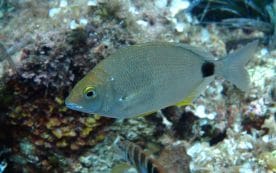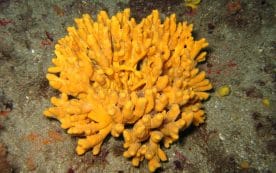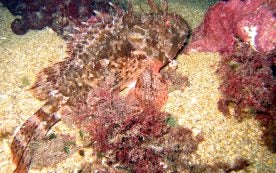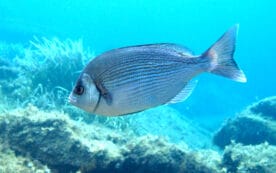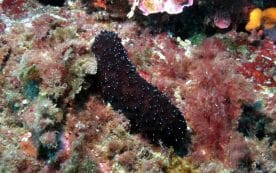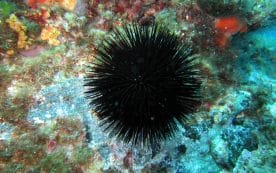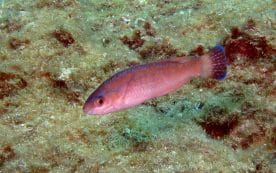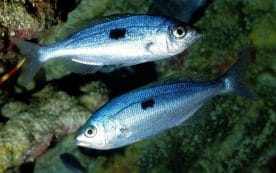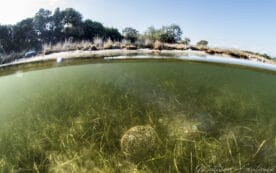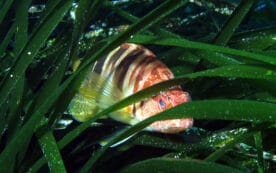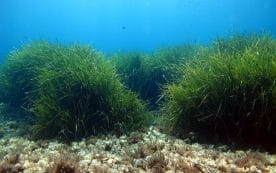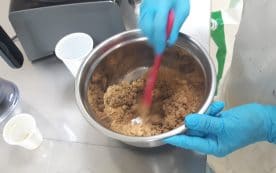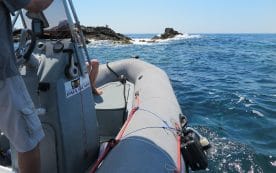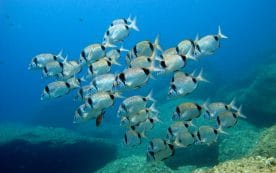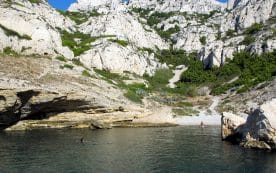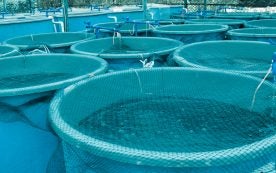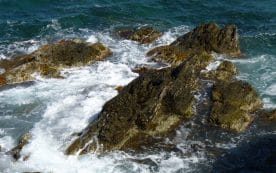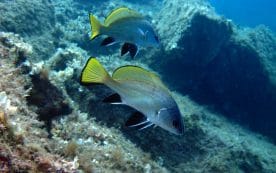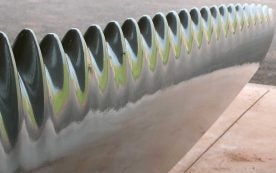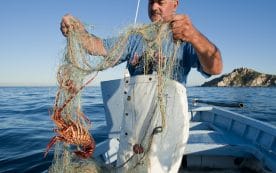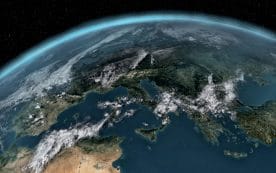Measuring no more than 20cm, the annular seabream is the smallest of the Mediterranean seabream species. It is easy to recognise from its silvery-gold colour, the single black ring at the base of its caudal fin and its yellow pelvic fins. It lives in schools, feeding on small worms, molluscs, crustaceans and echinoderms. They prefer Posidonia seagrass down to 90m deep and are less frequently seen on rocky and sandy bottoms. They are found all over the Mediterranean and Black Sea, and from the Bay of Biscay to Gibraltar in the Atlantic.
Axinella sponge
There are two species of Axinella sponges in the Mediterranean. Both are arborescent with cylindrical orangey-yellow branches They are quite similar. The only differences are the number of branches and the shape of the osculum, a large orifice for excreting filtered water. Water enters the central cavity via the many small pores in the sponge’s walls, hence the name Porifera. These sponges can be up to 1m tall and live between the surface and 200m on coralligenous and rocky bottoms away from the light. They are found in the Mediterranean and nearby Atlantic waters.
Black scorpionfish
This small scorpionfish is no more than 25cm long with a brownish-grey or reddish body mottled with darker colours. Unlike other species, it does not have a skin flap on its lower jaw. It is a master of mimicry and can camouflage itself so well that it becomes practically invisible to escape its predators and surprise its pray, lying in wait on the bottom for a crustacean or fish to come within range. It is found in Posidonia seagrass beds and on rocky bottoms down to 800m all over the Mediterranean, and from the British Isles to Senegal in the Atlantic.
Black seabream
The black seabream is a beautiful silvery-grey fish tinged with blue, green and pink. It has broken longitudinal gold lines along its sides and its caudal fin has a black border. It has quite a high, flat body and a slight depression on its head above its eyes. This becomes a bump on the heads of old individuals, which can measure up to 60cm. The black seabream lives in schools. It is omnivorous and can feed on seaweed or small invertebrates, especially crustaceans. Rare in the Black Sea, it is found in the Mediterranean and from Scandinavia to Angola in the Atlantic. It lives on all types of sea bottoms at up to 200m deep.
Black sea cucumber
This large sea cucumber (25cm long) is black to deep brown with white or beige spots on the tips of its papillae. It feeds by swallowing sand and absorbing food particles and debris into its digestive system. It has practically no predators apart from the Triton snail. It is found in the Mediterranean and Atlantic on sandy/muddy bottoms or more rarely in Posidonia seagrass beds down to depths of 100m.
Black sea urchin
It can be distinguished from the edible sea urchin because it is flatter, always black with thinner spines and its tube feet do not have any suckers. Unlike the purple sea urchin, it cannot right itself if it is turned on its back. The test can be 5 to 6cm with spines that are 3cm long. It is a grazing herbivore and is not edible. It is found all over the Western Mediterranean, in the Adriatic and Aegean Seas and from Gibraltar to Senegal in the Atlantic. It lives on rocky bottoms down to 50m deep.
Blacktailed wrasse
This little wrasse is 12 to 15cm long with a pink-brown body and a black tail with a white border. During spawning periods, the males deploy more attractive colours and fluorescent blue spots. It feeds mostly on parasites that it collects from other fish. It performs this cleaning in specific locations and fish wishing to use its services will adopt a distinctive position. Some stop moving and point their heads downwards or upwards, while others remain horizontal and open their mouths and opercula. The species is endemic to the Mediterranean but not found in the Black Sea. The blacktailed wrasse lives in Posidonia seagrass beds and on rocky bottoms down to 25m.
Blotched picarel
The blotched picarel has quite an elongated profile with a single dorsal fin and a forked caudal fin. It has a blue-grey or greenish-grey back and silvery sides sometimes scattered with small black spots. This genus has a distinctive rectangular black blotch on either side, and blue and yellow lines and dots appear during spawning periods. These fish can be up to 25 cm long and live mainly in Posidonia seagrass meadows and on sandy bottoms down to 100m below the surface. They are found in the Atlantic from Portugal to Morocco and all over the Mediterranean but very rarely in the Black Sea.
Boarfish
This fish has a very unique shape. It has a flat, disk-shaped body and is pink or orangey-red, sometimes with yellow vertical stripes. It can snap up small crustaceans, molluscs and worms with its highly protractile mouth. It has big eyes and measures no more than 16cm. Living on rocky, sandy or muddy bottoms between 40 and 600m deep, it is rarely seen by divers. In the Mediterranean, boarfish occur in the western basin and in the east part of the eastern basin. In the Atlantic, they range from Norway to Senegal.
Brown comber
This fish is no more than 15cm long, making it the smallest of the three comber species in the Mediterranean. It has a pinkish yellow to reddish brown body with 2 to 5 dark brown bands on its sides. There is a large black spot in the middle of its dorsal fin and its pelvic fins are black. It feeds on small fish and invertebrates. It prefers to live on sandy or muddy bottoms but is also found on rocky bottoms and in Posidonia seagrass from about 10 to more than 100m deep. It is found all over the Mediterranean except in the Black Sea, and from Portugal to Senegal in the Atlantic.
Brown meagre
Its dark grey-brown body with flashes of gold or bronze distinguishes it from other fish, making it one of the most elegant in the Mediterranean. It has two confluent dorsal fins, one of which has a black border like the anal fin. The first rays of the anal and pelvic fins are pearly white. The brown meagre lives between the surface and 180m in small groups in the mouths of crevices and caves where it can take shelter. It comes out at night to hunt for crustaceans, fish, worms and molluscs. It can grow to 50cm long and is found in the Mediterranean, the Black Sea and in the Atlantic from south of the British Isles to Senegal.
Brown wrasse
There is no difference in colouring between males and females but colours vary according to the individual. The young fish are usually green or brownish with lighter spots. Older individuals become dark blue with a bright blue border on the dorsal, caudal and anal fins. The brown wrasse uses its strong jaw to feed on invertebrates, sea urchins, worms, molluscs and crustaceans. It can grow to 45cm long. Found all over the Mediterranean and nearby Atlantic waters, it lives on rocky bottoms and in Posidonia seagrass down to 50m below the surface.
Bucchichi’s goby
Like all Mediterranean gobies it is a small fish, no more than 10cm long. Its colouring is grey-beige to brown with longitudinal rows of dark brown spots. There is an elongated black mark at the upper base of the pectoral fins. It feeds on small invertebrates like worms, molluscs and crustaceans. To reproduce, it lays its eggs under a stone or shell, where the male guards them until they hatch. The larvae are planktonic. It is mostly found on sandy bottoms but also on rocky bottoms and in Posidonia seagrass, close to the surface. The species is found all over the Mediterranean including the Black Sea and in nearby Atlantic waters.
Calcareous green alga
The algal body is formed by a chain of small, slightly calcified disks that vary in diameter from 5 to 25mm and are about 1mm thick. They are often covered in other algae and small epiphytic invertebrates. They vary in colour from light to dark green. Calcareous green alga can reach heights of up to 50cm. It prefers shady, rocky bottoms between the surface and 75m deep and is found in the Mediterranean, the Atlantic and the Indo-Pacific.
Caulerpa prolifera
This is a common algae whose blades can be up to 50cm long and 3cm wide. The blades are flat, spear-shaped and shiny green. In caulerpa prolifera, reproduction is mainly vegetative i.e. asexual. It prefers sandy or muddy bottoms between 1m and 15m below the surface. It is found in the Mediterranean, the Black Sea and also in the Atlantic from southern Spain and the Canary Islands to the Caribbean.
Comber
The comber is usually brick red to russet yellow in colour, with a salmon pink belly. It has 7 to 9 dark vertical bands crossed by one white stripe. This solitary, territorial fish is a voracious predator that feeds on fish, cephalopods, crustaceans and worms. It measures about 20cm, 40 at most, and lives down to 500m deep on all types of seabeds with a preference for rocky bottoms. It is found all over the Mediterranean including the Black Sea. In the Atlantic, they occur from the British Isles to Cabo Verde.
Common cuttlefish
Cuttlefish have wide flat bodies with white and brown mottled backs and much lighter stomachs. They have eight short arms covered in rows of suckers on their head, around the mouth. They use their two longer tentacles, which only have suckers on the ends, to capture prey. The pupil of the cuttlefish’s big eyes is very characteristic. It is iridescent blue and shaped like the letter W. It has a fin running around its entire body that ripples when it moves. The largest cuttlefish can measure up to 45cm, double that if you include the length of its 2 longest tentacles. They are found in the North Sea, the English Channel, the Atlantic and the Mediterranean from the surface to 200m deep. They prefer loose bottoms, seagrass beds and macroalgae.
Common octopus
The eight arms of the common octopus have two rows of suckers and can span up to 2 metres. It crawls across the seabed but can also swim in open water. If it senses danger, it will change colour to blend with its surroundings or expel a cloud of black ink and escape. It eats mainly crustaceans and molluscs. The males and females mate in the spring, and the female lays tens of thousands of eggs in clutches attached to the ceilings of rocky crevices. The species is found all over the Mediterranean and the Atlantic down to depths of 150m, on all types of seafloors wherever it can find cavities, such as holes in rocks, shipwrecks, amphora etc.
Common seabream
It has an oblong body and a convex head with a slight bulge near the eyes. It has a silvery pink back and a darker head with small blue spots, especially on young individuals. It has dark marks at the base of its pectoral fins and a caudal fin with white tips. Common seabream are carnivorous. They eat crustaceans, molluscs and fish and can grow to 75cm long. They live on rocky and sandy bottoms down to depths of 250m. The juveniles are mainly found in Posidonia seagrass. They occur all over the Mediterranean except in the Black Sea, and from the Bay of Biscay to Mauritania in the Atlantic.
Conger eel
The smooth, snake-like body of the conger eel has no scales and can be up to 3 metres long! It has a rounded snout and its upper jaw protrudes over the lower jaw. Its dorsal, caudal and anal fins are confluent. Its body can be light or dark grey with a white border on the fins. Conger eels feed on fish, crustaceans and cephalopods and live in crevices on rocky bottoms, in wrecks and on sandy bottoms down to depths of 100m. They can be found in the Mediterranean including the western part of the Black Sea, and from Norway to Senegal in the Atlantic.
Cuckoo wrasse
The male cuckoo wrasse has a blue and green head and front body while the rest of its body and fins are yellow or orange with turquoise lines and spots. The females and juveniles are salmon pink, orange or red with three distinctive black spots on their backs, the first two at the base of the dorsal fin and the third one at the base of the tail. These black spots are separated by smaller white ones. The cuckoo wrasse can measure up to 35cm and mainly eats crustaceans. They can be found in the Mediterranean except in the Black Sea, and from Norway to Senegal in the Atlantic. They live on rocky bottoms and coralligenous drop-offs between 10 and 200m below the surface.
Cylinder anemone
The cylinder anemone grows a long tube burrowed deep into the sand and will disappear inside it if it senses danger. It measures 30 to 40cm in diameter with two whorls of tentacles of varying lengths. It is a hermaphrodite animal that captures small planktonic organisms by paralysing them. The species is endemic to the Mediterranean where it lives on sandy or muddy bottoms and among Posidonia rhizomes between the surface and 40m deep.
Deep-snouted pipefish
This strange-looking fish measures up to 35cm long and has an elongated body and a long and laterally flattened snout. It is brownish or greenish-brown with lighter marks or bands. It preys on small crustaceans, fish eggs and fry. It lives in Posidonia and zostera seagrass from the surface down to 20m and likes brackish water. It is found all over the Mediterranean including in the Black Sea, and also in the Atlantic from Norway to South Africa.
Dusky grouper
This large fish (up to 1.30m long) has a red-brown body scattered with yellowish spots and a white border on its caudal and anal fins. However, it can turn either very pale or grey with silvery spots or dark bands depending on its mood or sexual phase. It is an active predator that hunts other fish, crustaceans and cephalopods. It is a protogynous hermaphrodite, so the females turn into males between the age of 9 and 12. In France, the dusky grouper has been protected since 1993 by a moratorium on line and spearfishing. It lives among cracks, crevices and boulders along rocky coasts from the surface down to 200m. It is found all over the Mediterranean except in the Black Sea. In the Atlantic it occurs from south of the British Isles to South Africa in the east, and in Argentina and southern Brazil in the west.
Dustbin-lid jellyfish
The dustbin-lid jellyfish is a large and slightly opaque jellyfish that usually measures 30 to 60cm but can be as much as 1m wide. It can be white, yellow, orangey-brown, green, blue or mauve in colour and drifts in currents, feeding on zooplankton. Its bell has 80 to 100 lobes or lappets around the rim and a thin blue or mauve border. Unlike other species it does not have stinging tentacles. It is found along coasts all over the world but also in lagoons and estuaries.
Fan mussel
An adult fan mussel can measure up to 1m20. It looks like a giant mussel partly emerging from the sediment. The anterior part of younger individuals is covered in spiny scales that progressively disappear in adults. Like other bivalves, the fan mussel is a filter feeder that filters seawater through its gills to extract phytoplankton, but it also draws nourishment from organic deposits in the sediment. In France, it has been a protected species since 1992. It is found on loose substrates, phanerogam beds, rough sand and gravel from the surface to 60m deep. It is endemic to the Mediterranean.
False coral
False coral is a bryozoa, which are small animals with a crown of hollow tentacles around the mouth and that live in colonies. It secretes a calcium carbonate skeleton which is bushy and orangey-pink and looks like coral. This species can be up to 20cm tall and feeds on small planktonic organisms and organic waste. It is shade-dwelling and hence found in areas of reduced light, such as crevices, vertical walls and rocky overhangs from 10 to 50m deep. It is found in the Mediterranean and the Atlantic.
Gilt-head seabream
The gilt-head seabream has a silvery oblong body with a large black mark at the operculum with red beneath it, and a golden stripe between the eyes. Seen singly or in small schools, it can be as long as 70cm. It starts life as a male and becomes female at 2 to 3 years old. This is called protandric hermaphroditism. It is found in Posidonia seagrass meadows, coastal lagoons and on sandy bottoms down to depths of 150m. The juveniles prefer to live in estuaries and shallow coastal waters. Gilt-head seabream are found all over the Mediterranean but are rarer in the eastern part of the Black Sea. In the Atlantic, they are found from the British Isles to Cabo Verde. They have been farmed since the 1970s.
Gorgon’s head
It folds itself into a big ball that can be up to 20cm wide, but when it unfolds its ten long arms, this strange animal looks a bit like a net with curly mesh on the ends and can extend to 80cm. It feeds by capturing food particles carried by the current and is also called a basket star. It is very sensitive to light, which causes it to fold itself in. It is found in the western Mediterranean and in the eastern Atlantic tropics between 50 and 800m deep. It is usually found attached to gorgonians.
Greater amberjack
Its tapered body shape is ideal for swimming. It has a large head and a very forked, jagged caudal fin. It has a bluish or purplish-grey back and silvery or creamy brown sides and belly with yellow markings the same colour as its fins. A broad, black band sometimes appears at the back of its neck. Juveniles have darker vertical bands. This large species measuring nearly 2m generally lives in schools, feeding on small fish and occasionally invertebrates. The greater amberjack is a pelagic fish found in the open sea and by the coast. It occurs in the Mediterranean but not the Black Sea, and in the Atlantic from south of the British Isles to Gibraltar and from Canada to Brazil. It is also found in the Persian Gulf and in Australian and Japanese waters.
Green spoonworm
The greenish females are rarely seen as they shelter in crevices, rock holes and concretions. Their soft, bulbous bodies measure 5 to 6cm and have an extendible proboscis. This is a tubular mouthpart with a groove on the dorsal side and a sort of spoon (or bifid tendril) at the end that it uses to capture food, plankton and organic waste. The minuscule male (1 to 3mm long) lives as a parasite in a brood pouch close to the female’s genital sac, fertilising her eggs as she produces them. The green spoonworm has a cosmopolitan distribution across all types of sea floors from the surface to more than 1000m deep.
Green wrasse
Unlike many species, the males and females look the same. Their colour can vary and is usually green or brownish, sometimes yellowish or orangey, with lots of small white spots on the sides and at times a white band from the snout to the tail. The green wrasse grows to a maximum of 45cm and feeds on fish and crustaceans. It likes rocky bottoms and Posidonia seagrass beds anywhere from a few metres below the surface to 50m deep. They can be found in the Mediterranean, the south-western part of the Black Sea and in nearby Atlantic waters.
Leopard-spotted goby
The leopard-spotted goby is a cave-dwelling species that is easy to recognise because of the brown, red or orange spots on its body and head. The body in the background is blue-grey, cream or pinkish. It feeds on small crustaceans, worms and molluscs. It is a small fish, no more than 13cm long, which lives on the sandy bottoms of underwater crevices and caves down to 40m deep. It is found all over the Mediterranean though rarely in the south, and from Scotland to Morocco in the Atlantic.
Lesser slipper lobster
The lesser slipper lobster has a squat, greenish-brown body with red and blue markings in between each tail segment. Its antennae look like two wide paddles in front of its head. It is smaller than the Mediterranean slipper lobster, measuring no more than 12cm. It hides by day, living in dark rock crevices, caves and Posidonia seagrass rhizomes, and prefers to come out at night to look for food. The lesser slipper lobster lives between the surface and 50m, in the Mediterranean except the Black Sea, and in the Atlantic from the Gulf of Guinea to Scotland and Brazil to North Carolina.
Lobster
This large crustacean can be recognised from its dark blue colour with beige spots, its red antennae and two giant claws. It uses the thinner one to cut pieces of fish flesh and the larger one to crush shells. They can be up to 60 cm long.
The lobster is a solitary animal that lives along rocky coastlines in cracks and crevices from 25 to 100m deep. They are found in the Mediterranean except in the Black Sea, and in the Atlantic from Morocco to Scandinavia.
Longsnout wrasse
The longsnout wrasse has a long body that is very laterally compressed. Its long, pointed snout is concave on the top. It has variable colouring, from rusty to reddish or greenish, and often has a light longitudinal line along its head. The female has a black urogenital papilla. The longsnout wrasse measures no more than 13cm long and feeds on small benthic invertebrates. It lives in Posidonia seagrass meadows and on rocky bottoms down to 20m below the surface. It is endemic to the Mediterranean and found in the western Black Sea.
Longstriped blenny
Endemic to the Mediterranean, this blenny measures 8cm or less. It has a black or dark brown stripe running along its entire cream-coloured body. Brooding males also have a green spot at the base of their pectoral fins and the tentacles above their eyes are orange and larger than the females’. The longstriped blenny feeds on tiny crustaceans and seaweed that it finds on rocky bottoms and in coralligenous habitats between the surface and 40m deep.
Mediterranean fanworm
This marine worm lives inside a 20 to 30cm-long tube of its own making. It builds it from fine particles that it secretes itself, and can retract inside the tube. The branchial plume is cylindrical and arranged in two lobes of different sized spirals. The main lobe has several whorls and 200 to 300 filaments. It is very colourful (white or yellow with purple bands), has a respiratory function and is also used to capture plankton or particles drifting in the current. The Mediterranean fanworm lives on rocks or sometimes protruding from the sand, between 0 and 50m deep. It is found in the Mediterranean and from Senegal to the North Sea in the Atlantic.
Ornate wrasse
Ornate wrasse have very variable colouring but as adults, they have distinctive turquoise markings, while the juveniles are all green with a black spot in the middle of their backs just under the dorsal fin. The females are greenish-brown with thin transversal streaks and five transversal blue bands. The males are yellowy-green with the same vertical streaks and a single blue band behind the pectoral fins, often with a red outline. Their heads are partly purplish-red with a blue pattern. The caudal fin is forked in adults. The ornate wrasse is a protogynous hermaphrodite and swims with quick jerky movements as it hunts for small molluscs and crustaceans. Males can grow to 25cm. This species is mainly found near the surface in Posidonia seagrass but can descend to 150m deep. They can be found in the Mediterranean except in the Black Sea, and in the Atlantic from Portugal to Cape Lopez. They are more abundant in the southern Mediterranean but with global warming they have appeared off the coast of Provence in recent years.
Painted comber
This beautiful fish can be identified by its purplish-blue stomach and what look like fine, painted blue and red lines on its cheeks, hence its name. Its yellowish-red body has 5 to 7 dark brown vertical stripes. It is very solitary and actively defends a territory of a few square metres. It feeds on crustaceans and fish and can grow to 36 cm long. It lives in Posidonia seagrass meadows and on rocky bottoms down to 150m below the surface. It is found in the Mediterranean, the Black Sea and in the Atlantic from south of the British Isles to Senegal.
Pandora
The pandora is an oblong fish. The upper profile of its head is straight and it has a pointed snout. Its body is pink and covered in small blue dots. The upper border of the operculum is crimson red and it has a reddish mark at the base of its pectoral fins. The biggest pandora are 60cm long. This carnivorous species feeds on benthic invertebrates and fish and is found all over the Mediterranean but rarely in the Black Sea. In the Atlantic, they occur from the British Isles to Cabo Verde. They live on all types of sea bottoms at up to 200m deep.
Peacock blenny
This species shows pronounced sexual dimorphism. The females are dark while the males are more brightly coloured and have a crest on their head. The peacock blenny has a greenish-yellow body with vertical blue stripes that become spots at the rear. On its temple, behind its eye, it has a dark eyespot with a blue or pink ring. This small blenny measuring no more than 13cm enjoys a diet of molluscs and algae that it finds in shallow water above rocky and sandy bottoms. It lives in the Mediterranean but is not found in the southern part of the eastern basin and rarely in the Black Sea. In the Atlantic, it ranges from the Bay of Biscay to Morocco.
Pink flabellina
The pink flabellina is one of the prettiest nudibranches in the Mediterranean. At just 3 to 5cm long, it has a slim, elongated body with a tail and is covered with small outgrowths called cerata that help it breathe. The two tentacles on its head are shaped like antelope horns and are called rhinophores, which are sensory organs it uses to smell. It also has two long tactile tentacles at the front of its head and two very short tentacles around the mouth. It lives between 5 and 50m below the surface on rocky bottoms covered in hydroids, its source of food. It is found all over the Mediterranean and in the eastern Atlantic. Like most nudibranches, it is a hermaphrodite species.
Purple sea urchin or Common sea urchin
The purple sea urchin has very sharp spines that are about 3cm long on a 7cm test. It can be light or dark brown, greenish or purple in colour. Like other sea urchins, it grazes on algae using its jaw, which is a complex 5-toothed structure called Aristotle’s lantern after the Greek philosopher and physicist who first described it. During spawning, the males and females release gametes into the water where fertilisation occurs. The larvae live as plankton and then turn into young sea urchins that fall to the sea bottom. They occur on rocky bottoms and in Posidonia seagrass beds down to 100m below the surface. They are found all over the Mediterranean but not in the Black Sea, and are also seen in the Atlantic from the UK to Mauritania.
Mauve stinger
The bell of this small jellyfish is barely 10cm in diameter. On the underside, it has 4 oral arms in the centre and 8 tentacles or filaments that contain stinging cells and can be several metres long. It is transparent and dotted with luminescent pink or violet spots. It has the worst sting of all jellyfish in the Mediterranean. This planktonic species is found in the Mediterranean and in the north-east Atlantic up to the North Sea.
Did you know? When jellyfish invade our coastal waters, they do not “swim” towards the beach. They are simply transported by surface currents and pushed by the wind.
Mediterranean slipper lobster
The Mediterranean slipper lobster can be as long as 45cm. Its body seems practically square, almost as wide as it is long. It has no claws but it has flattened antennae that look like shields. It is a reddish-brown colour, lighter on the ventral side, and its antennae and limbs have dark mauve tips. It is a placid and slow-moving animal that feeds on worms, shellfish and carrion. Mediterranean slipper lobsters live in caves, holes and on mud from 5m to 100m deep. They can be found all over the Mediterranean except in the Black Sea, and in the Atlantic from Portugal to Cabo Verde.
Midget sea squirt
The delicate midget sea squirt lives in bunches held together by a thin stolon, making them look like a colony when in fact each individual is independent. Shaped like a small, transparent club, they are white or yellowish and less than 1cm high. They are transparent, making it easy to spot the 6 to 8 opaque pharyngeal slits that filter water to feed them with plankton. They are found on rocky bottoms from the surface down to 50m in the Western Mediterranean and in nearby Atlantic waters.
Monaco shrimp
It is called the Monaco shrimp because of its colouring, which is brownish-red to bright red with longitudinal white lines. It has a dorsal carina and a jagged rostrum. Its maximum length is 5cm. This shrimp keeps out of the light, living in rocky areas and Posidonia seagrass from the surface down to 50m. It is found in the Mediterranean and in nearby Atlantic waters.
Moray eel
This snake-like fish has no scales and can be as much as 1.30m long. It has a large, bullet-shaped head with protruding nostrils. Its dorsal, caudal and anal fins are confluent and it is without pectoral and pelvic fins. Its colouring varies. It can be chocolate brown or mauve and mottled with yellow or white. Moray eels live in crevices on rocky bottoms down to more than 100m deep. They are found all over the Mediterranean except in the Black Sea, and in the Atlantic from the British Isles to Senegal.
Orange-red encrusting sponge
Encrusting sponges form a kind of crust on the substrate on which they live. This species varies from dark orange to red in colour. It is often found on the valves of sessile shellfish like spondylus or oysters, and is endemic to the Mediterranean.
Rainbow wrasse
Rainbow wrasse have two very different colourings. In the initial phase, juveniles, females and primary males have orangey-brown backs and white bellies. The large, secondary-phase territorial males responsible for reproduction can grow to up to 25cm and are much more colourful. The belly is white while the back is green-brown with an orange zigzag band with blue borders running from head to tail and a black blotch in the centre. Rainbow wrasse feed on molluscs, crustaceans, worms and sea urchins. They live on rocky bottoms and in Posidonia seagrass beds down to 120m below the surface. They can be found in the Mediterranean, the south-western part of the Black Sea, and from Norway to Gabon in the Atlantic.
Red black-faced blenny
The red black-faced blenny is a small fish of no more than 8cm with a pointed head and a small mouth. It has 3 dorsal fins and its pelvic fins look like tripods. Females and non-territorial males are light grey to brown in colour with 5 dark transversal bands. Territorial males are bright red with a black head. They adopt very territorial and even aggressive behaviour during spawning periods. The red black-faced blenny feeds mainly on small crustaceans and lives on shallow rocky bottoms (6m), often preferring shady vertical walls. It is endemic to the Mediterranean but rarely found in the southern part of the eastern basin. It also occurs in the western Black Sea.
Red coral
Yes, red coral is an animal! It is a colonial species formed of polyps that build a branched skeleton attached to a hard substrate. The retractile polyps are white with 8 tentacles containing stinging cells. The skeleton is formed from spicules of calcium carbonate and is very strong with a beautiful red colour (sometimes pink or white). The largest branches can be more than 50cm. Red coral feeds on planktonic prey and can also absorb dissolved organic matter. This shade-dwelling species only grows where there is little light, such as on cave and crevice ceilings, under rocky overhangs or on deep vertical walls from 10m to more than 200m deep. The species in endemic to the Mediterranean and is found in the western basin and in the Adriatic. A few sites have also been reported in the Atlantic from southern Portugal to Cabo Verde.
Red-mouthed goby
Of the many goby species, this is probably the easiest to recognise, with its reddish-brown body with light and brown spots and its bright red lips! This small and very solitary fish is no more than 18cm long and feeds on small invertebrates. It lives on all types of sea bottoms between 10 and 20m deep. It is found in the Mediterranean except in the Black Sea, and from the Ireland to Morocco in the Atlantic.
Red scorpionfish
The red scorpionfish spends most of its time on the seabed. It feeds on fish, crustaceans and molluscs that it can easily capture with its protractile jaw. Its colour is variable, from brick red to pink or orange with dark blotches. The numerous skin appendages on its lower jaw and the rest of its body make it easy to recognise. This mostly solitary fish can grow to 50cm, making it the largest of the Mediterranean scorpionfish. It is found all over the Mediterranean but not in the Black Sea. It is also found in the Atlantic from the British Isles to Senegal. It lives on rocky and sometimes sandy bottoms between 20 and 200m below the surface.
Red starfish
This species is a bright red or brick red colour with small pits on its arms. Its round arms have small feet – called tube feet – with suckers on the end. It uses them to move around and collect and feed on organic particles from the sea bottom. The red starfish has a diameter of about 20 centimetres. It lives on rocky bottoms and in Posidonia seagrass beds down to depths of 300m. They are found all over the Mediterranean except in the Black Sea, and from Great Britain to Cabo Verde in the Atlantic.
Saddled seabream
The body of the saddled seabream is oblong and longer than the white seabream. Its mouth is oblique and it has a silvery grey body that is darker on the back, and fine black longitudinal lines on its sides. There is a large black mark with a white border on the caudal peduncle. Saddled seabream feed on small invertebrates and measure up to 30cm at most. They live on rocky bottoms and in Posidonia seagrass down to 30m below the surface. They are found all over the Mediterranean but are very rare in the Black Sea. In the Atlantic, they occur from the Bay of Biscay to Angola.
Salema
Salema have long, oblong bodies, small heads and blunt snouts. They are silvery or blueish grey with about 10 clearly marked golden, longitudinal stripes and a black spot at the base of their pectoral fins. The caudal fin is dark grey. Salema swim in tightly-packed schools composed at times of several hundred individuals. It is one of the few herbivores among Mediterranean fish and grazes on algae and the soft tips of Posidonia seagrass. It can grow to 45cm long. Typically observed in seagrass beds, this species also lives on algae-covered rocky bottoms down to 70m deep. It is found all over the Mediterranean but rarely in the Black Sea. In the Atlantic, it occurs from the Bay of Biscay to South Africa.
Sea bass
Its slender body is usually silvery grey with a darker back. It has two dorsal fins that are almost confluent. With its torpedo-shaped body, it is a quick swimmer and hence a formidable predator, feeding on fish and cephalopods. Young sea bass often live in schools whereas the adults are more solitary. It is a delicious food fish and often bred in fish farms. It is found down to depths of 100m over all types of seafloors and also in brackish water in the Mediterranean, the Black Sea and from Norway to Senegal in the Atlantic.
Seahorse
There are two species of seahorse in the Mediterranean, Hippocampus hippocampus and H. guttulatus. Their colour can be brownish or blackish and sometimes H. guttulatus is bright red or yellow with little blue spots. Its head is at right angles to the rest of its body, and H. hippocampus has a smaller snout. It has no fins on its tail but can wrap it around something to hold on. It measures about 15cm and is a very poor swimmer, moving slowly in an upright position using its dorsal and pectoral fins. It hunts for small crustaceans or fish fry that it captures with a swift movement of its head. The species is not protected and is becoming increasingly rare.
They are found in Posidonia and Zostera seagrass and in seaweed between the surface and 50m deep. Both species are found all over the Mediterranean including the Black Sea, and in the Atlantic from south of the British Isles to the Gulf of Guinea.
Sharpsnout seabream
Recognisable from its distinctively sharp, protruding snout, it is silvery grey with a dozen vertical stripes that are alternately light and dark black, with a black ring on its caudal peduncle. It can measure up to 60cm long and feeds on algae, worms and shellfish. It lives on rocky bottoms down to 150m deep all over the Mediterranean and more rarely in the Black Sea. In the Atlantic it is sometimes seen in the Bay of Biscay and from Gibraltar to Cabo Verde.
Shi drum
These many wavy golden lines with dark edges run diagonally across its blue-grey metallic coloured body. The shi drum has a single, short, thick barbel under its chin. They feed on benthic invertebrates and measure up to 70 cm at most. The adults live on rocky and sandy bottoms down to 100m deep. They can be found in the Mediterranean, the Black Sea and into the Gulf of Suez, and from Brittany to Senegal in the Atlantic.
Slender goby
The slender goby has a mottled brownish to beige body with a dark blotch under its eye and a series of rectangular marks along its side. It feeds on small invertebrates, especially crustaceans, and measures up to 16cm at most. It lives on sandy and muddy bottoms close to Posidonia seagrass beds down to 30m below the surface. It is endemic to the Mediterranean and is rarer in the southern part.
Small-spotted catshark
The small-spotted catshark is less than one metre long with two dorsal fins. It has a yellowish or brownish body spotted with little dark marks. This nocturnal fish feeds on small fish, crustaceans and molluscs and can be found all over the Mediterranean except in the Black Sea, and from Norway to Senegal in the Atlantic. It lives on sandy or muddy bottoms down to 400m deep. It can be found in fish markets skinned and de-headed, where it is called rock salmon because of its pink flesh.
Spinous spider crab
The spinous spider crab is protected by a beautiful, rounded red carapace that can measure up to 25cm long and 18cm wide. In large individuals, this carapace is a little wider than its length. In smaller ones, it is the opposite. It has distinctive wide spines around the edges that are alternately long and short. It also has a line of small spines across the midline of its back. Of its 6 legs, the front pair are smooth and wide with claws, while the others are slim and covered in tiny hairs. Its eyes can retract and are situated on either side of two sharp spears called a rostrum. This species is endemic to the Mediterranean and is found on all types of bottoms between the surface and about 50m deep. However, the young crabs stay close to the coast between the surface and 20m.
Spiny lobster
The spiny lobster has a pair of long, flexible antennae and can be up to 50cm long. It is red-brown in colour with yellow spots and lines, especially on its legs and antennae. It is a nocturnal animal that hides in holes and crevices during the day. Its main prey are shellfish and dead fish. It lives in rock crevices and Posidonia seagrass beds from 10m to 500m below the surface and is found all over the western Mediterranean and in the Atlantic from the British Isles to Mauritania.
Spiny starfish
The spiny starfish is one of the largest species of starfish in the Mediterranean. Reaching up to 80 centimetres in diameter, it is a voracious predator, feeding on shellfish, crustaceans and sea urchins that it captures beneath the stones and in the cavities where it lives. Each of its five arms has three rows of thick folds covered in spines, which give it a bulky appearance. Its colouring is variable, from salmon pink to brown or green. It is also found in the Atlantic from the United Kingdom to Senegal down to depths of 200 metres.
Stone bass
The stone bass, also known as the Atlantic wreckfish, is a large fish with a big head, very characteristic because of its angular profile and protruding jaw. The body is greyish-brown in adults and purplish or lilac with black blotches in juveniles. The young fish live near the surface for a while then once they are adults, they move to deep water, sometimes over 500m. Some of the largest individuals are more than 2m long. They feed on fish, crustaceans and molluscs. The stone bass is found all over the Mediterranean but not in the Black Sea. In the Atlantic, it occurs from Norway to Angola in the east, and also on the north-east coast of the USA.
Striped red mullet
The striped red mullet spends most of its time searching for small invertebrates by digging in sandy bottoms and sediment with its two barbels, leaving small craters in its wake! It has an elongated, cylindrical body covered in large scales and two dorsal fins. The front one is spiny and has brown and yellow bands. The yellow caudal fin is concave. Adult striped red mullet are pinky beige with a darker stripe, whereas juveniles have blueish bodies. The largest individuals can be up to 40cm long and weigh almost 1kg, but they live in deep water down to 100m. They occur from the North Sea to the north-east Atlantic and in the Mediterranean and Black Sea. They live on loose, sandy or gravely bottoms and in zostera and Posidonia seagrass beds and often search for food near rocks.
Striped seabream
The striped seabream has a long, ovoid, compressed body. The upper profile of its head is slightly convex and it has a protractile mouth. It is silvery grey and has about fifteen vertical, dark brown stripes on its sides. It feed on worms, crustaceans, molluscs and sea urchins. It grows to about 55cm
and lives on sandy or muddy bottoms down to 80m deep. Striped seabream are found in the Mediterranean except in the Black Sea, and in the Atlantic between the Bay of Biscay and Cabo Verde. They are also seen in the Red Sea and the southwest Indian Ocean.
Sunset cup coral
Sunset cup coral is bright yellow. It has a round skeleton that can grow to up to 17mm in diameter and 60mm high. The polyps on top measure up to 30mm. This animal is found attached to hard substrates. Sunset cup coral is very sensitive to light and lives under rocky overhangs, in cave mouths and on shady coralligenous drop-offs. It can be spotted just a few metres below the surface but mostly lives at depths of between 20 and 50m. It is found all over the Mediterranean and in the Atlantic up to the south of the British Isles.
Thicklip mullet
The thicklip mullet has a tapered body and large, flat head with a short, blunt snout. It has a distinctive thick upper lip with small tubercles. It has a blueish grey back and silvery sides and stomach striped with fine, dark, longitudinal lines. The thicklip mullet lives in schools and feeds on seaweed, small invertebrates or detritus. It measures 60cm long at most. In winter it lives offshore and moves to coastal waters, estuaries, lagoons and harbours in the spring. It is found all over the Mediterranean except in the Black Sea, and from Norway to Morocco in the Atlantic. The females are particularly prized for their roe, which is pressed, cured in salt and dried to make a well-known delicacy called “Poutargue”.
Tompot blenny
The tompot blenny has a long, squat body and a large head with a big mouth and thick lips. It is rusty-brown with 6 or 7 darker brown stripes extending onto the dorsal and anal fins. Its body and head are dotted with small white spots. Averaging 15 to 20cm long (and up to 32cm at the most), the tompot is the largest blenny in the Mediterranean. It feeds on seaweed and small invertebrates, including young sea urchins and ophiuroids, living around rocky bottoms that have holes, crevices or boulders and Posidonia seagrass, from the surface down to depths of 30m. It is found in the Adriatic and Aegean Seas and the Western Mediterranean basin and from Ireland to Morocco in the Atlantic.
Two-banded seabream
On its silvery grey, oval body, the two-banded seabream has a broad triangular black stripe running from the back of its neck to the base of the pectoral fin, and a black ring close to the tail. The end of the caudal fin is also black. They are carnivorous fish that enjoy a diet of worms, crustaceans and molluscs. They can grow to 45cm long and live on rocky and sandy bottoms down to depths of 70m. The juveniles live in Posidonia seagrass. They are found all over the Mediterranean but not the Black Sea, and also in the Atlantic from the south of the British Isles to Angola.
Udotea
Its fan-shaped fronds on a thin peduncle often have serrated edges. The algae are olive green and measure about 10cm and can be kept in an aquarium. This species prefers shady, rocky bottoms between the surface and 120m deep. It is found all over the Mediterranean, and in the Atlantic from Cabo Verde to the Canary Islands.
Violescent sea-whip
A characteristic species of Mediterranean coralligenous habitats, the violescent sea-whip forms colonies of between 30cm and 1m high. It is usually crimson, hence its name, although some are yellow, either completely or at the tips. Each polyp can be up to 8mm in size and they cover the fan’s entire surface. They allow the animal to capture food particles carried by the currents. They like shade and so are most often found on north-facing drop-offs, underneath overhangs or in cave mouths. They occur from 10m to more than 100m deep all over the Western Mediterranean and in the Atlantic near Gibraltar.
Violet sea urchin
The violet sea urchin has a distinctively round shape and short, blunt spines. At most, the test measures about 10cm and the spines 3cm. It is usually violet with white tips on the spines. It is a grazing herbivore that lives in Posidonia seagrass and on rocky bottoms down to 100m below the surface. Violet sea urchins are found all over the Mediterranean except in the Black Sea, and in the Atlantic from Gibraltar to Senegal.
White seabream
The white seabream has a light grey body with silvery tinges and a darker face. It has five dark black vertical stripes on its back and sides interspersed with four lighter ones. Young individuals only display the 5 dark stripes. There is a black blotch on the top of its caudal peduncle. Juveniles feed on algae, worms and small molluscs while the adults, which can be up to 45cm long, are carnivorous and feast on worms, molluscs, crustaceans and echinoderms. White seabream live on rocky and sandy bottoms down to depths of 50m. The juveniles spend the summer in lagoons and estuaries then move to Posidonia seagrass meadows in the autumn. Found all over the Mediterranean, they are rarer in the Black Sea. In the Atlantic, they occur from the Bay of Biscay to Cabo Verde.
Yellow gorgonian
Yellow gorgonians are colonial animals that construct a soft tree-shaped skeleton. The contractile polyps have eight tentacles. Both the colony and the polyps are orangey-yellow in colour. The branches grow perpendicular to the dominant currents so that it can capture its food. The tallest yellow gorgonians can be 50cm high. They are found in the Mediterranean and also to the north of the Bay of Biscay in the Atlantic. They grow on vertical walls and shady rocky overhangs between 5 and 100m below the surface.
Yellowmouth barracuda
This pelagic fish usually swims in schools but is sometimes solitary. It has a long silver body with some twenty black streaks and a yellowish caudal fin. The head is very elongated and its lower jaw is longer than the upper one. This formidable predator feeds on fish, squid, cuttlefish and crustaceans that it captures and devours with its razor-sharp teeth. It is about 80cm long but some individuals reach 1.5m.
Dotted seaslug
The dotted seaslug or cow snail is one of the easiest nudibranches to recognise with its white body covered in brown spots! These spots are thought to discourage predators by telling them that the dotted seaslug is not edible. It is a hermaphrodite animal that generally measures 5 to 7cm although some individuals are a little larger. It can be found from just a few metres below the surface in shady areas in cave mouths or under overhangs. It feeds on sponges and is often found on them.
Dog’s teeth
This is one of the biggest fish in the Mediterranean. It has a compressed, oval body and a large head. In adults, the back is silvery grey or blue-grey and covered in blue-green spots, while the sides are silvery with pink tinges. Young fish are greyish with black spots on their backs. Juveniles live in schools but the adults are solitary animals. They feed on fish and molluscs and can measure up to 1m long. They like rocky bottoms down to depths of 200m and are found in the Mediterranean except in the Black Sea, and from the Bay of Biscay to Mauritania in the Atlantic.
Peacock wrasse
It has quite a tall body with a long head, pointed snout and big lips. At 35cm long, it is the largest member of the wrasse family. Its body colour varies depending on age, sex and breeding activity. They all have a more or less distinct dark “moustache” mark that extends to the eye, a black spot on the caudal peduncle and 3 or 4 dark, longitudinal stripes. The females are brownish-grey or greenish while the males display more vivid reds, bright yellows, greens and blues. This fish feeds by taking a mouthful of seaweed and grinding it in its mouth to extract tiny invertebrates. It begins life as a female then changes sex in later life. It is found in the Mediterranean, the western part of the Black Sea, and from Spain to Morocco in the Atlantic. It lives in Posidonia seagrass meadows and on rocky bottoms down to 50m below the surface.
Axillary wrasse
In this particular member of the vast labridae family, sexual dimorphism is very noticeable. The females are yellowish-brown with dark brown spots and a dark blue urogenital papilla. The males are brownish, greenish, pink or blue-grey with blue lines and spots and their colours become very vivid during breeding season. Both males and females have large black blotches on their caudal peduncle and at the base of the pectoral fins. They are about 15cm long and feed on a diet of molluscs, worms and sea urchins. They can be found in the Mediterranean and in nearby Atlantic waters but not in the Black Sea. They live in Posidonia seagrass beds and on rocky bottoms down to 50m.
Snipefish
The snipefish is a small fish measuring 10 to 20cm long that lives close to sandy or muddy bottoms at 50 to 500m below the surface. It feeds on small invertebrates, especially crustaceans, which it finds on or near the seabed. It has a golden pink back and a silvery-pink belly. The second spine of its dorsal fin is long and strong.
Grey triggerfish
With its high, flat, oval body, the grey triggerfish has a very distinctive shape. The first of its two dorsal fins has three spines, and it can use the middle one to hold the larger front one erect. Its particularly thick, rough skin is a brownish grey colour with blue-green spots on the head and fins. They can grow to a maximum of 50cm and live near rocky seafloors between 10 and 100m deep and are often found in mussel beds. They occur in the Mediterranean, the Black Sea and on both sides of the Atlantic, from the North Sea to Angola in the east and from Nova Scotia to Argentina in the west.
Red sea squirt
The red sea squirt is a solitary animal no more than 10cm high and coral-red on one side and lighter on the other. It is cylindrical and shaped like a wineskin bag with two siphons with cruciform edges with a frill of protective “hairs”. The animal feeds on plankton-rich water that it sucks in through the upper siphon, filters in the pharynx then blows out through the side siphon. The tunic is grainy and rigid and made of tunicin, a substance similar to cellulose. It lives away from bright light on rocky bottoms and among the rhizomes of Posidonia seagrass. It is found down to depths 100m in the Mediterranean and in the Atlantic from Gibraltar to Mauritania.
Snakelocks anemone
The snakelocks anemone is a large sea anemone that can reach up to twenty centimetres in diameter. It is most widespread in the Mediterranean but is also found in the north-east Atlantic and the North Sea. It has approximately 200 greyish-beige tentacles that form a crown around its mouth and have purple, blue, reddish or green tips. They contain stinging cells that allow it to paralyse and capture small prey, plankton or fish. They are eaten in the South of France and Corsica as “sea nettles”. The snakelocks anemone lives on rocky bottoms from the surface to about 20 metres deep.
Cardinalfish
This small fish is about 15cm long with a compressed, salmon pink to bright red body and 2 or 3 black spots at the base of its caudal fin. Its eyes are black with two horizontal white stripes. It lives alone or in small groups from the surface down to 200 metres, preferring to stay in dark caves and crevasses. It feeds on small fish and crustaceans. As well as the Mediterranean, it is found in the Atlantic from Gibraltar to the Gulf of Guinea.
Swallowtail seaperch
The swallowtail seaperch, whose Latin name is Anthias anthias, is one of the Mediterranean’s most colourful fish. It has a salmon pink, oval body with yellow streaks or spots on its head and fins. The tail fin is forked and it has very large pelvic fins with a white, purple or yellow border. The swallowtail seaperch lives in schools of several hundred fish above rocky bottoms and wrecks between 10 and 200m deep in the Mediterranean and also in the Atlantic from Portugal to Angola. It feeds on small fish and planktonic crustaceans.
Greater pipefish
The great or greater pipefish is a member of the Syngnathidae family. It lives in Posidonia seagrass and cymodoceaceae meadows or on sandy bottoms at depths down to around 100 metres. In these meadows, its elongated body and grey-brown colour with yellow, pink or greenish hues provide perfect camouflage among the leaves, allowing it to surprise small crustaceans and fry that pass within its reach. It can measure forty about centimetres long. This Mediterranean fish is also found in the Black Sea and in the Atlantic, all the way from Norway to South Africa.
Knobbed triton
This triton has a very large shell that spirals into tapered points at both ends. It is yellowish with brown markings. The animal inside is orangey-pink with two black bands on its tentacles. It is the largest gastropod in the Mediterranean and can measure up to 40cm. The knobbed triton feeds mainly on echinoderms, sea cucumbers and starfish. It lives on rocky and sandy-muddy bottoms from depths of about 40m and more. It is mainly found in the Mediterranean’s western basin and in the Bay of Biscay.
Ocellated wrasse
The ocellated wrasse gets its name from the red-rimmed, eye-like marking, sometimes called an ocellus, on the posterior dorsal edge of its operculum. Both males and females also have a distinctive dark spot on the caudal peduncle. Their body colour varies: females and juveniles are greenish-brown with a lighter belly and two dark longitudinal lines, while males are a brighter green or brown/orange colour with blue, red and green lines on their heads. This fish can be up to 12cm long and feeds on small benthic invertebrates in Posidonia seagrass beds and on rocky bottoms down to a depth of 30m. It is endemic to the Mediterranean.
Yellow Cluster Anemone
This bright yellow to orange colonial anemone grows and reproduces by budding. It is made of polyps measuring half a centimetre to 2cm in diameter, each with 34 tentacles arranged in two whorls. It is found on vertical walls and shady rocky overhangs at depths of between 5 and 200m in the Mediterranean and the Atlantic. The colony usually grows on sponges of the genus Axinella.
Damselfish
Juvenile and adult damselfish are so different in colour that they look like two different species. The young juveniles are electric blue and become brown, almost black, as adults. Damselfish have an oval body, a strongly protractile mouth and a markedly forked tail. In summer, the males will mark out a spawning area where the females come and lay their eggs. Damselfish live in schools above rocky bottoms and Posidonia seagrass beds from the surface down to 35m. They swallow tiny animals from plankton floating in the current. They can be found in the Mediterranean but not the Black Sea, and are also seen in the Atlantic from Portugal to Angola.
Shore rockling
The shore rockling is an elongated fish of up to 25cm at most. It has two dorsal fins: a small one at the front followed by a second one that stretches almost to the caudal fin. It has three barbels: one under its chin and two more near its nostrils. It has a brown or reddish back with lighter spots and a pale brown or cream-coloured belly. Shore rocklings are nocturnal and feed on fish, crustaceans and worms. They live in rock crevices and in Posidonia seagrass beds down to 100m deep. Apart from the south-eastern basin, they are found in most parts of the Mediterranean including the Black Sea. In the Atlantic, they occur from Norway to Gibraltar.
Common prawn
The common prawn has a totally transparent body adorned with colourful blue and yellow lines and spots. Its eyes are on stalks and the rostrum is jagged on both sides. It can be up to 10cm long and walks using the 5 pairs of legs on its thorax (prawns are decapods). It also has another 5 pairs of appendages on its abdomen that carry the eggs. It is omnivorous and nocturnal and prefers to feed on organic waste. It lives on rocky bottoms and in Posidonia seagrass from the surface down to 40m, in the Mediterranean and also between Denmark and Mauritania in the Atlantic.
Hermit crab
Unlike other crustaceans, the hermit crab’s carapace only protects its back so it has to squeeze its abdomen into the empty, salvaged shells of gastropods. Dardanus arrosor is the largest of the Mediterranean species. It has two powerful claws. The left one is much larger than the right. Its carapace is bright red or orange and it has blue eyes on red and white striped stalks. It lives on loose and rocky bottoms down to 100m and feeds on organic waste. Hermit crabs are found in the Mediterranean and also in the Atlantic from the Bay of Biscay to South Africa.
Beadlet anemone
Resembling a large flower when open and a tomato when closed, the beadlet anemone is one of the most common Mediterranean sea anemones and can be found in every ocean. It has a distinctive bright red colour with a blue ring around the edge. It can be found just a few centimetres below the surface attached to rocks by a 7 to 8 cm sucker at its base. Its 192 short, stubby tentacles are arranged in 6 circles around its mouth. Like other sea anemones, it feeds on small animals that it captures and paralyses with its tentacles.

